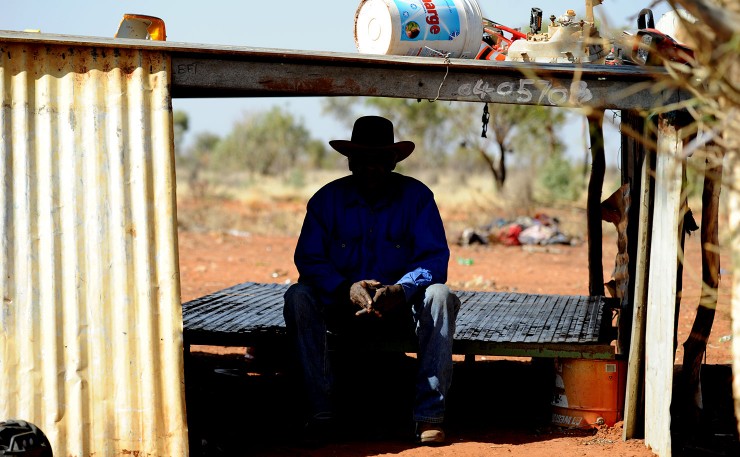You could get drunk this Australia Day, or try something different… learn about the real history of this nation. Amy McQuire helps you dip your toe in the water.
It’s one of the greatest myths about Aboriginal people: that before European invasion, Aboriginal people were simply living off the land, with no civilization and a culture that didn’t make it out of the ‘stone age’ despite tens of thousands of years of human habitation.
If you believe this trope, you would be one of those arguing that the invasion and the massacres and small pox and stolen children that came along with it, was all for the ‘greater good’.
You would be one of those on Twitter recently messaging me rubbish like “What have the Aboriginals invented? A throwing stick?” Or “Civilisation would have never progressed in this country”.
You would be one of those people who believes that Aboriginal people should be thankful and rather than whinge about ‘Australia Day’, instead start assimilating into society, and maybe bring along with you a side of lamb chops to throw on the barbie, mate.
But if you are one of those people, you really are regurgitating 19th century propaganda and after 200 years, I thought you might have advanced, just a little.
As you celebrate ‘Australia Day’ this year, maybe start to think not just of the massacres on the frontier, but also the strength of Aboriginal civilization, and how it has survived despite the repeated attempts to extinguish it.
Here is a handy guide to get you started:
Aboriginal people have architecture
If you have ever sweltered in the Queensland heat or shivered in the Canberra cold, you might have wondered what shelter Aboriginal people used over tens of thousands of years?
The myth that Aboriginal people didn’t have towns or villages was used by European colonists to paint blackfellas as primitive, a view that has still persisted to this day.
But different Aboriginal tribes had a diverse architecture that varied according to the climate and season. In some areas, campsites and villages were occupied all year round, while other camps were impermanent, and occupied depending seasonal patterns.
Professor Paul Memmott from the University of Queensland has documented the complexity of Aboriginal architecture extensively in his book ‘Gunyah, Goondie + Wurley: The Aboriginal Architecture of Australia’.
“The modest nature of ‘Aboriginal architecture’ poses numerous questions concerning the role of the built form in Australian Indigenous cultures… (it) was misconstrued by colonial immigrants as evidence of ‘primitive culture’, but on the contrary, there is now an abundance of documentation to indicate that Aboriginal vernacular architecture is an expression of the complex set of relationships between the physical environment and social environment.”

The fighting Gunditjmara in Lake Condah, down in Victoria, lived in large villages and fished for eel, setting up traps that still exist to this day, exporting their bounty across the country. And down in the small New South Wales town of Brewarrina, the fish traps on the Barwon River are said to be the oldest man made structures in the world.
Aboriginal people were the first bakers
The myth that Aboriginal people were ‘hunters and gatherers’ has also bled into this ‘primitive culture’ myth, and was used to justify the lie of ‘terra nullius’. As Prof Megan Davis has explained, settlement can occur when “when the land is desert and uncultivated and it is inhabited by backward people”.
So it suited the colonial project to paint Aboriginal peoples as ‘hunters and gatherers’ when the reality was far different – we had a sophisticated system of agriculture, and as Aboriginal author Bruce Pascoe outlines in ‘Dark Emu’, could have been the first people in the world to bake bread.
Aboriginal people were planting, irrigating and harvesting ancient grains and storing the surplus in houses and sheds.
As Pascoe writes in the Griffith Review: “We can accept that the world is round, that the globe is warming and smoking causes lung cancer but we cannot seem to accept as true or pertinent what the explorers witnessed of Aboriginal society and economy.
“European science has produced marvels and its foundation principle is curiosity. Why are we not curious that Aboriginal people could cultivate crops in the desert? Why do we pay no attention to the dams and irrigation techniques employed? When our farmers are so threatened by droughts, salinity, erosion and crop diseases, why do we not investigate the crops and farming techniques developed over thousands of years to accommodate the challenging characteristics of this continent?”
Aboriginal people were the first farmers
Tying into Bruce Pascoe’s work is Bill Gammage’s excellent ‘The Biggest Estate on Earth’ which outlines the complex system of land management that existed before invasion. Aboriginal people could have very well been the first farmers, but farmed their land without fences, using fire and other animals to manage country.
Rather than a view of untamed wilderness, Aboriginal people carefully managed every inch of the ‘great estate’, ensuring that it fit in with spirituality.
Gammage’s work has also been integral in overturning the myth of ‘hunters and gatherers’.
Aboriginal nations, he wrote “first managed country for plants. They knew which grew where, and which they must tend or transplant. Then they managed for animals. Knowing which plants animals prefer to let them burn to associate the sweetest feed, the best shelter, the safest scrub. They established a circuit of such places, activating the next as the last was exhausted or its animals fled. In this way they could predict where animals would be. They travelled to known resources, and made them not merely sustainable, but abundant, convenient and predictable”.
As we look at the catastrophic consequences on country of 200 years of European ‘settlement’, and consider the crisis we are facing as we warm the Earth, maybe we should start considering which ‘civilisation’ was superior?
Aboriginal people had the world’s oldest burial rituals
The ancient bones of Mungo Lady, found in the sixties in Lake Mungo down in western New South Wales, are evidence of the world’s oldest cremation. Last year, a new DNA study of Mungo Man’s 40,000-year-old remains confirmed links to modern-day Aboriginal people, finding that our mob were indeed the first peoples of this continent.
That would mean, that our people have had sophisticated burial rituals for tens of thousands of years, and could have been the first in the world to practice cremation, long before the ancestors of Europeans.
Aboriginal people were the first astronomers
There is a growing body of evidence that Aboriginal people could have been the first astronomers, gazing into the night sky and entwining their science with their daily lives. They used the night sky for navigation, and to chart the seasons, to determine when was best to plant and harvest.
This sophisticated science lives on today in the stories of the elders, and Aboriginal people had awe-inspiring knowledge of the universe before the heroes of western science.
For example, astrophysicist Ray Norris has said that the Yolngu people in north-eastern Arnhem Land knew “how the tides are linked to the phases of the moon”, long before Galileo incorrectly stated they weren’t.
“Some Aboriginal people had figured out how eclipses work, and knew how the planets moved differently from the stars. They used this knowledge to regulate the cycles of travel from one place to another, maximising the availability of seasonal foods,” Dr Norris wrote in the Conversation.
Euahlayi man Ghillar Michael Anderson has been heavily involved in documenting knowledge from his own people, who used the stars to navigate and travel outside country along trade routes, using the night sky as a ‘memory aid’.
Astronomer Bob Fuller has dubbed these like ‘star maps’, which the Euahlayi would use to travel, and it even extended from Goodooga up to the Bunya mountains for the famous Bunya Nut Festival.
Aboriginal people have sophisticated mathematics and physics
Aboriginal people had complicated number systems, that still exist to this day. Quandamooka mathematician Dr Chris Matthews has been documenting this as a way to make mathematics more culturally appropriate and accessible to Aboriginal children. He told me on 98.9 FM’s Let’s Talk programme last year: “I see mathematics as a different way of viewing the world. And it’s not divorced from any other culture around the world, the way I perceive it. Maths is still part of a process where we consider the world around us and go through an abstraction process to create these symbols to tell a story. They can be numbers, Greek letters, a whole range of symbols that we use.
“The important thing there is what we do, we attach meaning to those symbols by looking at the real world. They come from that. So when we observe that real world, we introduce our cultural bias every time we create something… in our communities we have a lot of structures that we represent with our own symbolism.”
An example is the Garma Maths in Yirrikala, in Arnhem Land.
“When you start delving into the kinship up there, it brings out all these structures of relationships,” Dr Matthews says.
“So from these ideas of connecting people to themselves, to other people, to country and so forth, you build up a structure. And those structures and things are mathematical ideas… that’s what maths does, maths looks at patterns and relationships and understands the structures that sits underneath that.”
So our kinship systems were a sophisticated form of mathematics, and the fact it governed the relationships between kin and country, and defined responsibility, leads to the idea that mathematics actually governed Aboriginal life in a way Europeans couldn’t grasp.
And if you are talking about physics, you can’t go further than the boomerang, which is a phenomenal example of aerodynamics which pre-dated Leonardo da Vinci’s flying machine.
Aboriginal people had the world’s first art galleries
If you have ever visited the endangered rock art galleries on Western Australia’s Murujagayou, or Burrup Peninsula, you would understand how sophisticated Aboriginal art and story telling was and is.
It is the highest and oldest concentration of rock art anywhere in the world, but has been under constant threat of ‘development’. Although an age hasn’t been definitively worked out, it is estimated to be about 30,000 years old.
There are an estimated 1 million images on the rock faces, including possibly the oldest depiction of a human face.
Donate To New Matilda
New Matilda is a small, independent media outlet. We survive through reader contributions, and never losing a lawsuit. If you got something from this article, giving something back helps us to continue speaking truth to power. Every little bit counts.





